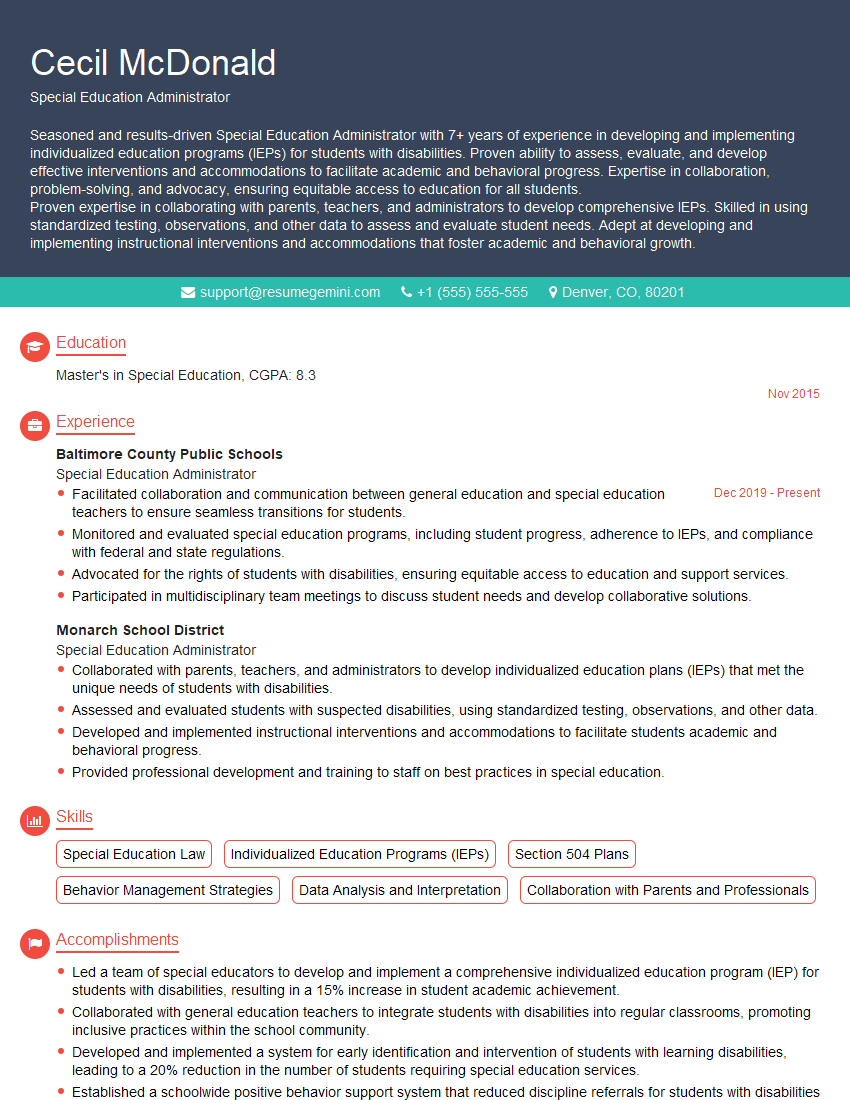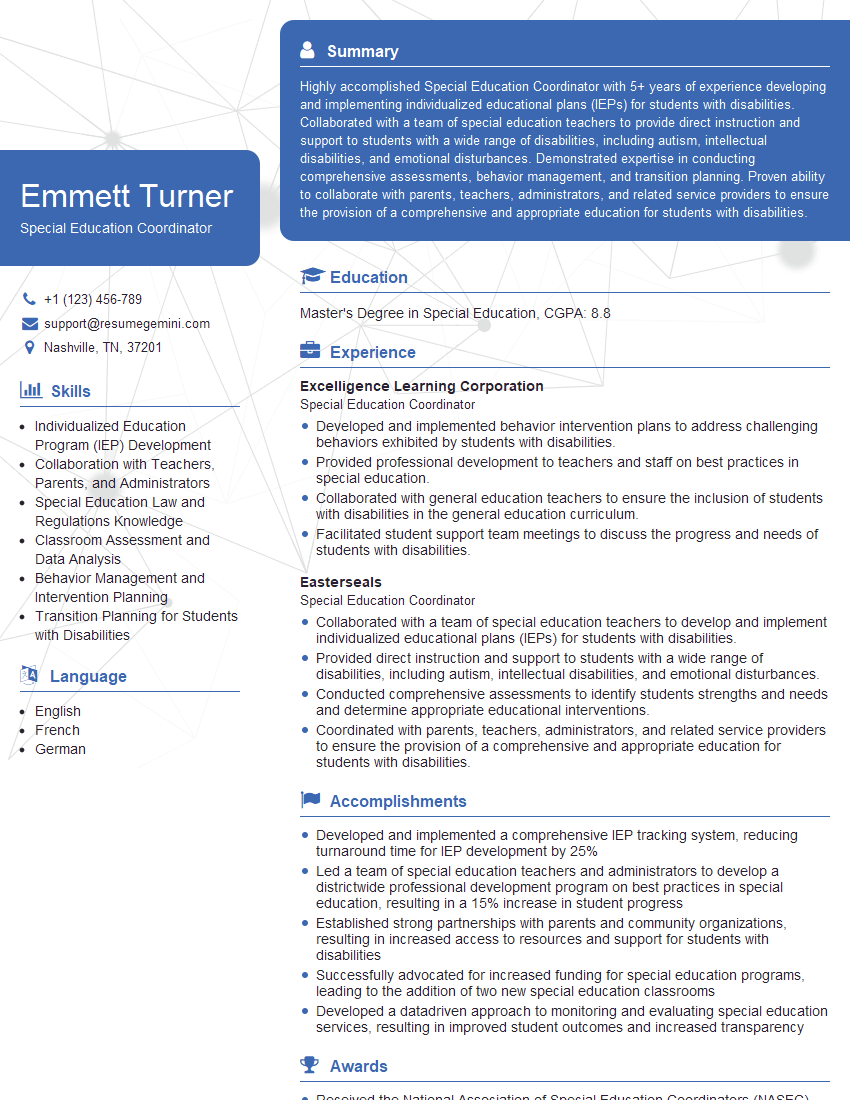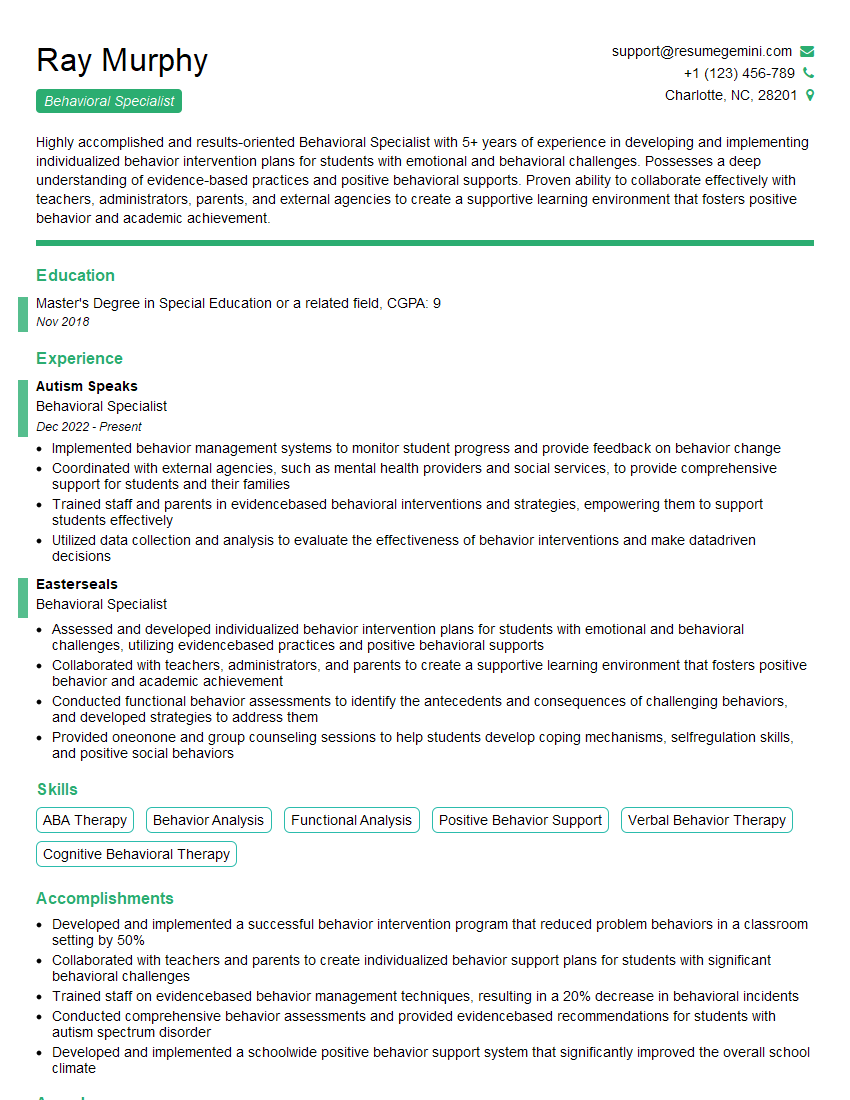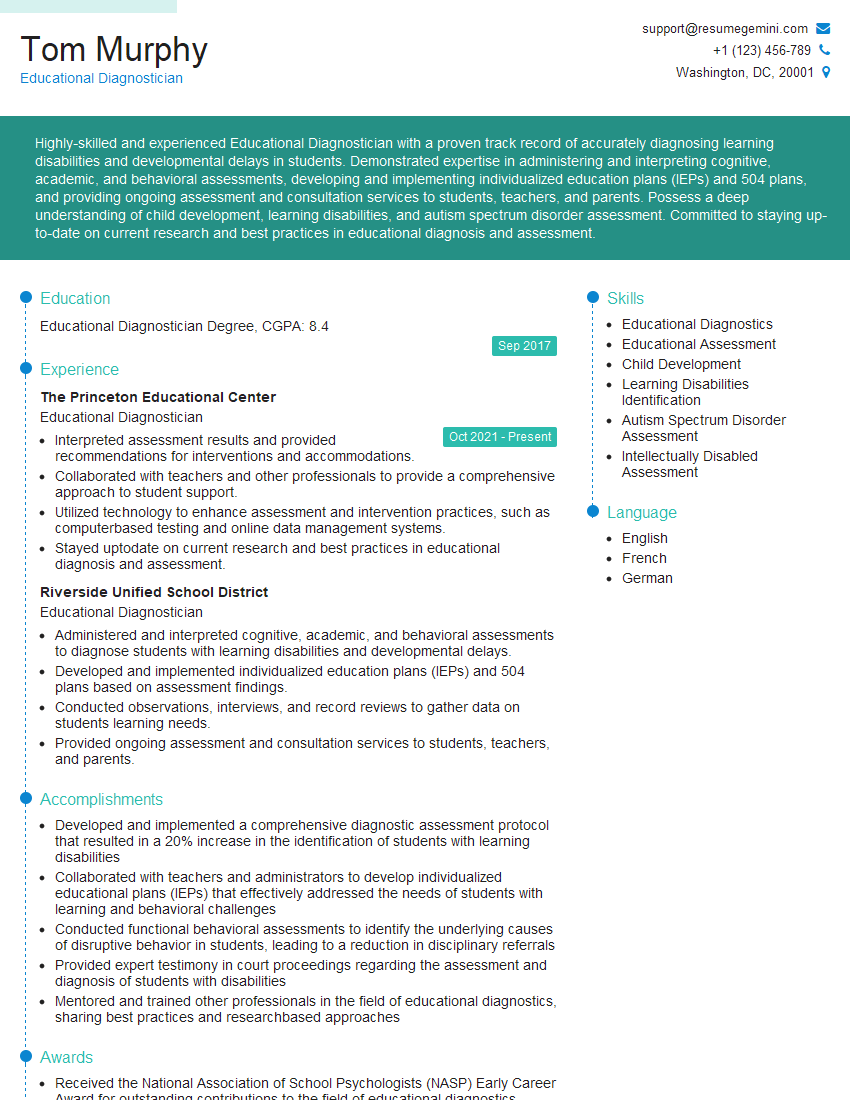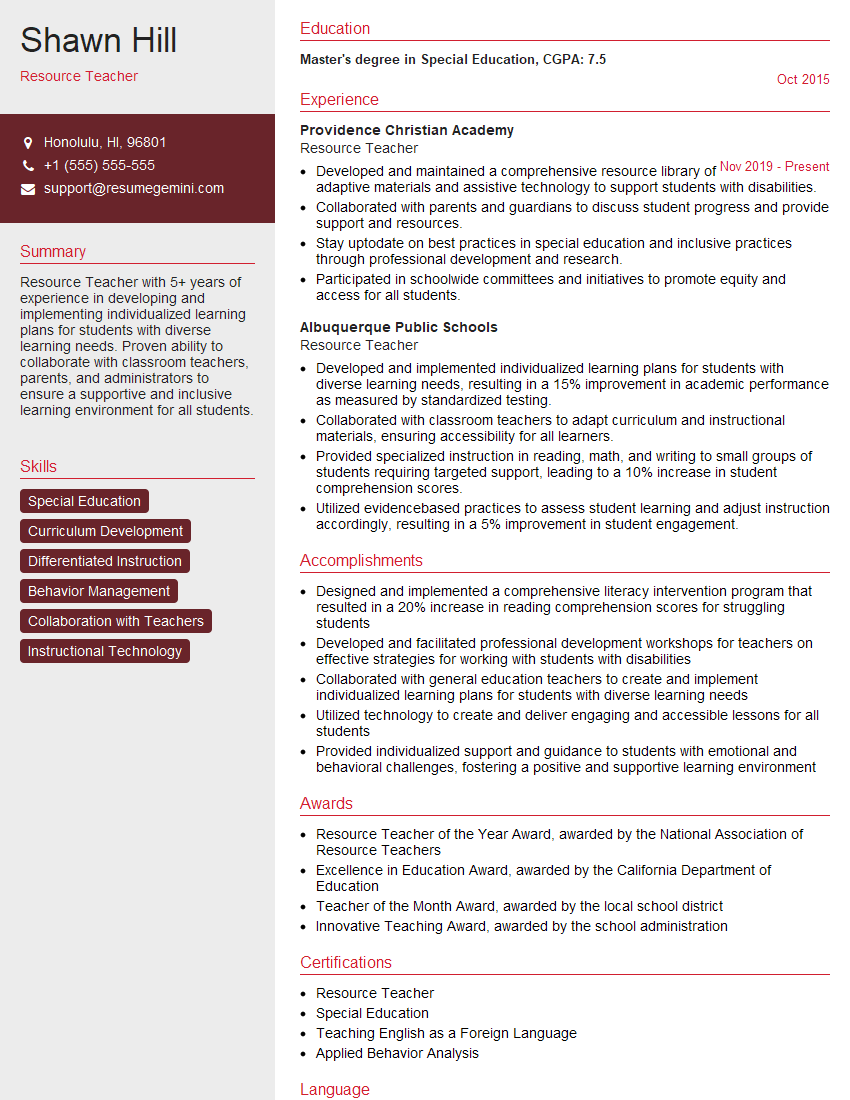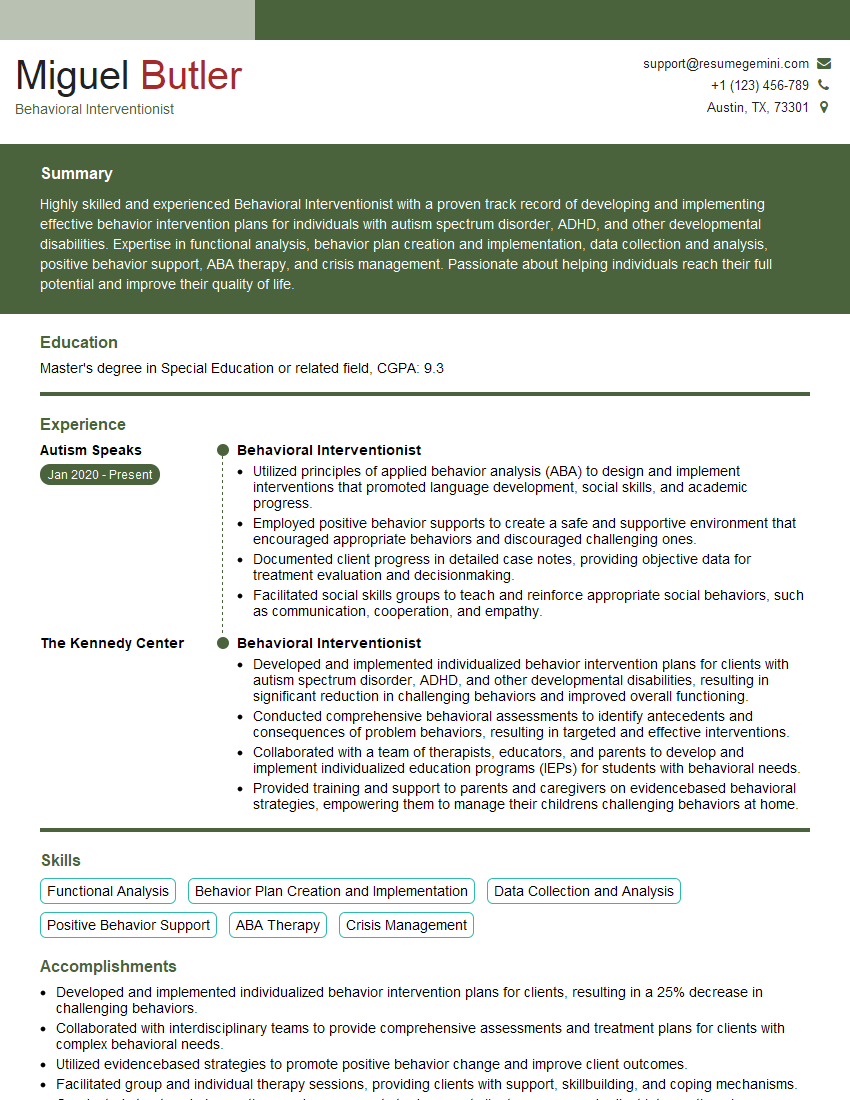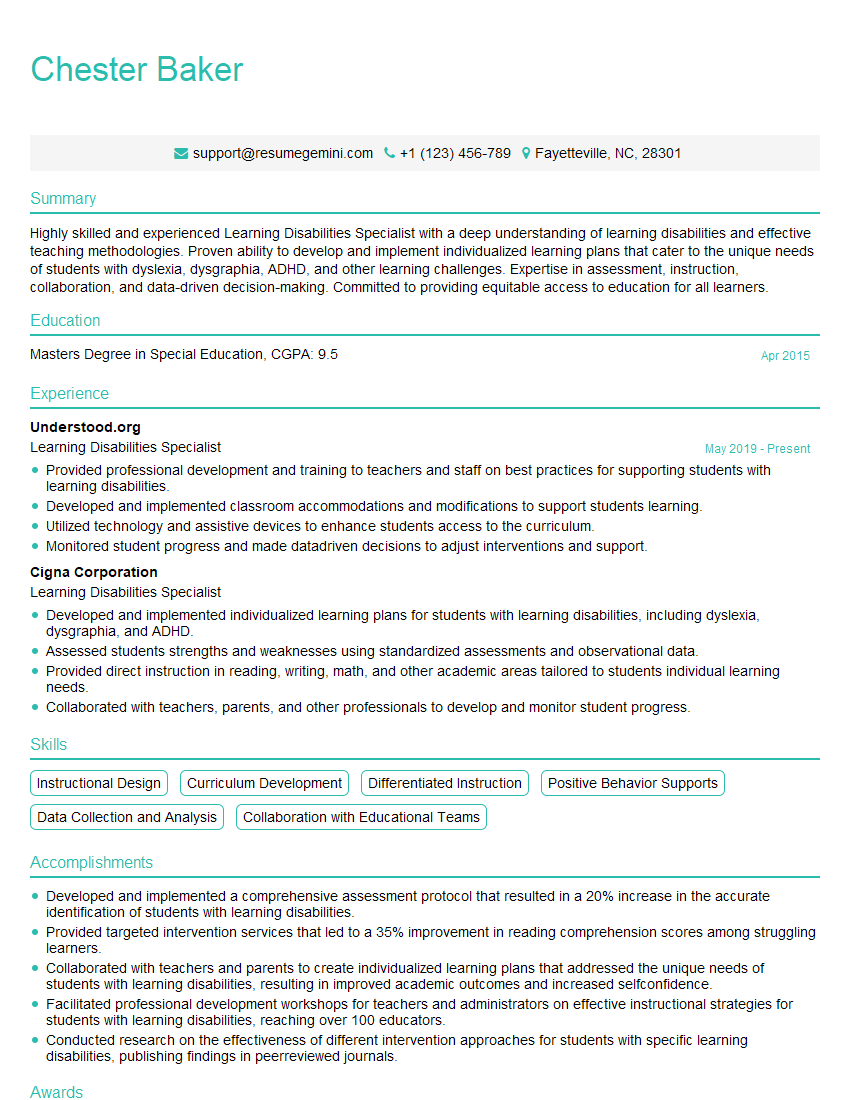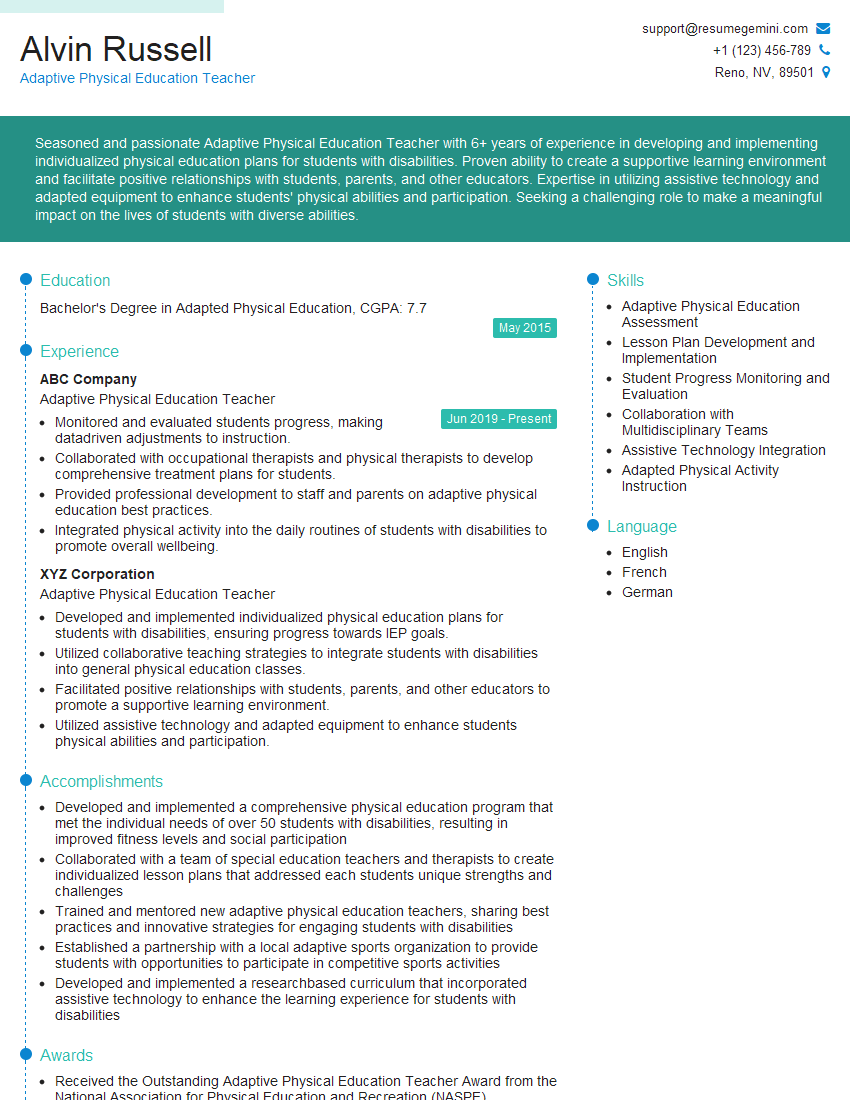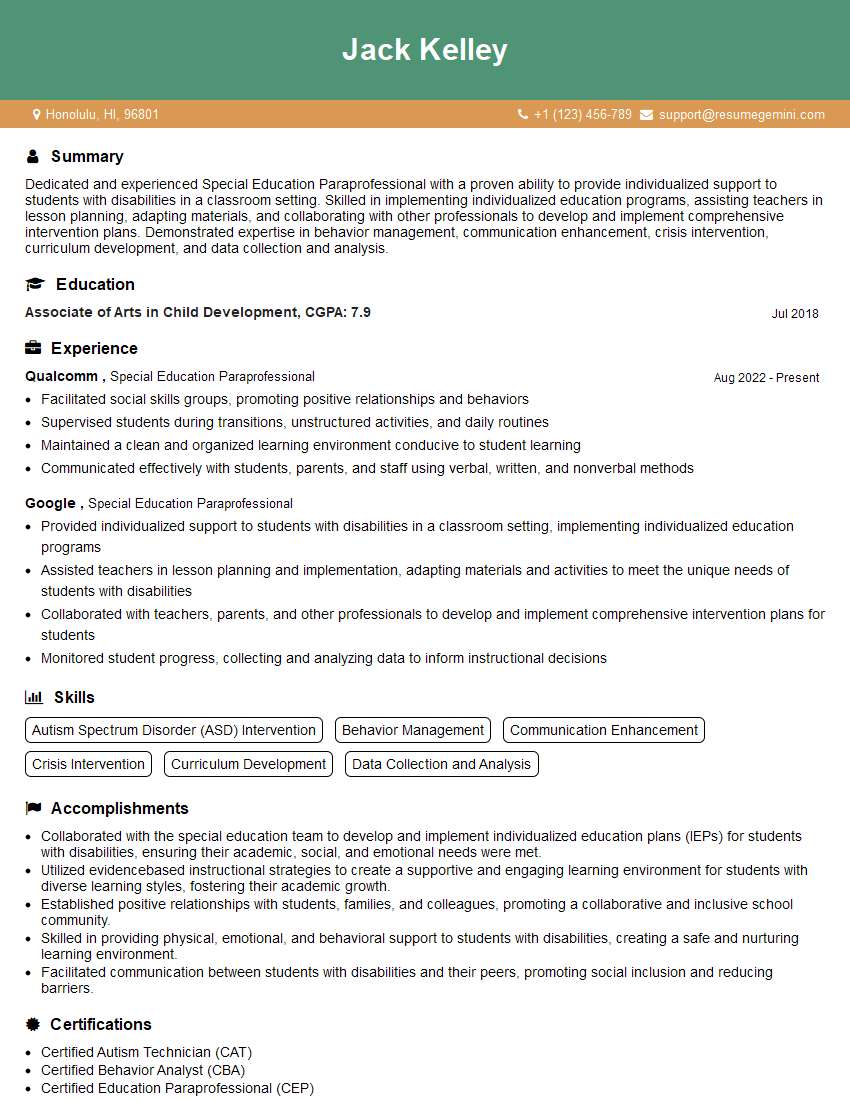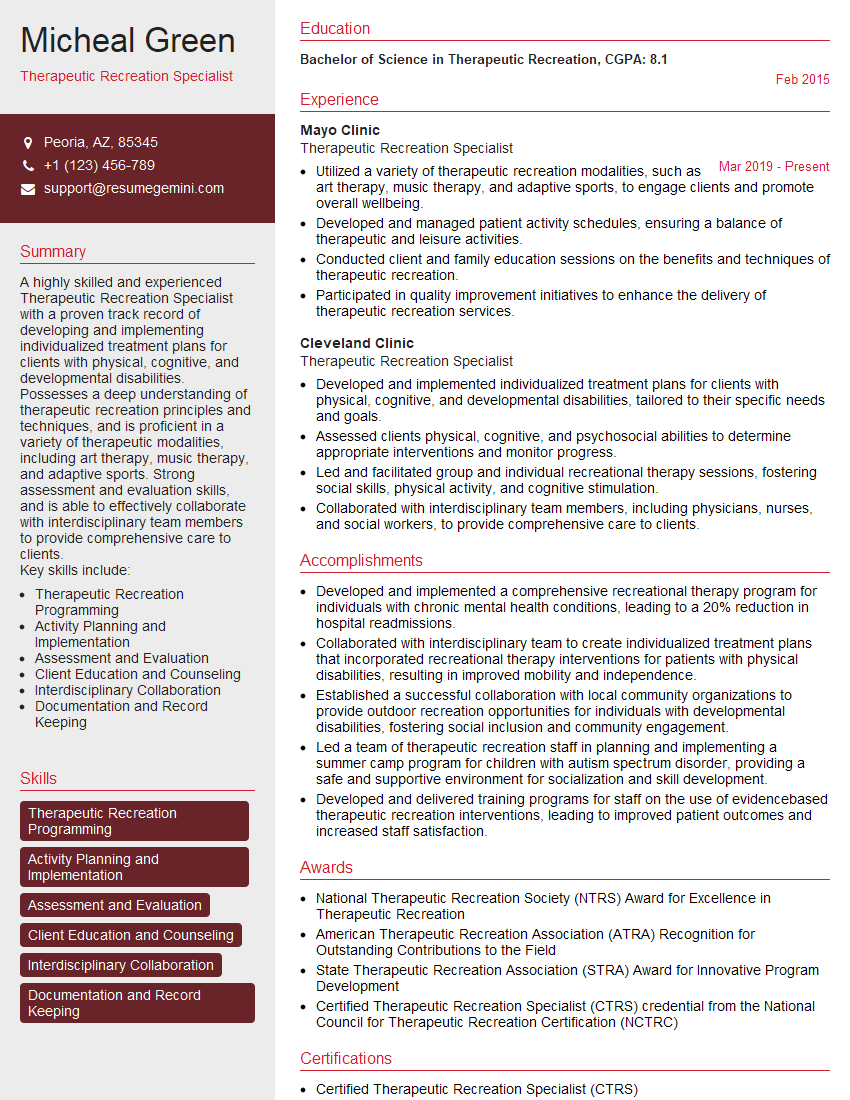Preparation is the key to success in any interview. In this post, we’ll explore crucial Knowledge of Special Needs Students interview questions and equip you with strategies to craft impactful answers. Whether you’re a beginner or a pro, these tips will elevate your preparation.
Questions Asked in Knowledge of Special Needs Students Interview
Q 1. Explain the Individualized Education Program (IEP) process.
The Individualized Education Program (IEP) is a legally mandated document designed to ensure students with disabilities receive the support they need to access and succeed in their education. It’s a collaborative process involving parents, teachers, specialists, and the student (when appropriate).
- Referral and Evaluation: The process begins with a referral, often from a teacher or parent, expressing concerns about a student’s learning or behavior. A multidisciplinary team then conducts a comprehensive evaluation to determine if the student has a disability and needs special education services.
- IEP Meeting: Once a disability is identified, an IEP meeting is held to develop the student’s individualized plan. This meeting involves all stakeholders and focuses on the student’s strengths, needs, and goals.
- Goal Setting: The IEP outlines specific, measurable, achievable, relevant, and time-bound (SMART) goals addressing the student’s academic, social, and behavioral needs. For example, a goal might be: “Increase reading fluency from 50 words per minute to 80 words per minute by the end of the semester.”
- Services and Supports: The IEP details the specific services and supports the student will receive, such as specialized instruction, assistive technology, or behavioral interventions. It also specifies the location and frequency of these services.
- Monitoring and Review: The IEP is a living document; it is regularly monitored and reviewed (at least annually) to ensure the effectiveness of the interventions and to make adjustments as needed. Progress toward goals is tracked, and the IEP is revised to reflect the student’s changing needs.
For example, I worked with a student with dyslexia who had an IEP that included specialized reading instruction, assistive technology such as text-to-speech software, and accommodations like extra time on tests. Regular monitoring showed improvement, and we adjusted his goals and strategies accordingly.
Q 2. Describe different learning disabilities and their impact on learning.
Learning disabilities are neurobiological differences affecting how individuals learn and process information. They are not caused by lack of intelligence or effort. Several types exist, each impacting learning differently:
- Dyslexia: Affects reading skills, impacting word recognition, fluency, and comprehension. Students may struggle to decode words, read accurately, or understand what they read.
- Dysgraphia: Impacts writing abilities. Students may have difficulty forming letters, spelling, organizing their thoughts on paper, or expressing themselves in writing.
- Dyscalculia: Affects math abilities, causing challenges with number sense, calculation, and problem-solving. Students may struggle with basic math facts, understanding mathematical concepts, or applying math skills to real-world problems.
- Auditory Processing Disorder (APD): Affects the brain’s ability to process auditory information, making it difficult to understand speech, especially in noisy environments or with rapid speech. Students may struggle to follow instructions, participate in class discussions, or understand lectures.
- Non-verbal learning disabilities: Affect visual-spatial skills, social interaction, and motor coordination. Students may have difficulty with visual-perceptual tasks, understanding nonverbal cues, or performing fine motor tasks.
The impact of learning disabilities varies depending on the individual and the specific disability. However, common challenges include difficulty with academic tasks, frustration, low self-esteem, and social difficulties. It is crucial to provide individualized support to address these challenges.
Q 3. How do you differentiate instruction to meet diverse learning needs?
Differentiating instruction is crucial for meeting diverse learning needs. This involves adjusting teaching methods, materials, and assessments to cater to individual student strengths and challenges. I use a variety of strategies including:
- Tiered Assignments: Providing different levels of complexity for assignments, allowing students to work at their own pace and level of understanding. For example, a research project could have different expectations for research depth depending on the student’s abilities.
- Flexible Grouping: Organizing students into groups based on their needs, allowing for targeted instruction. This might include small groups focused on specific skills or collaborative projects with mixed-ability groups.
- Varied Instructional Methods: Utilizing a variety of teaching methods, such as lectures, discussions, hands-on activities, and technology-based learning, to engage students with different learning styles.
- Assistive Technology: Using assistive technology tools such as text-to-speech software, graphic organizers, or speech-to-text software to support students with specific needs.
- Accommodations and Modifications: Providing accommodations, such as extra time on tests or preferential seating, and modifications, such as changing the assignment format or reducing the workload, to adjust the learning environment to meet individual needs.
For instance, I once had a class with students with a wide range of reading levels. I used tiered reading materials, providing easier texts for struggling readers and more complex texts for advanced readers. I also used a variety of instructional methods like read-alouds, guided reading, and independent reading to cater to diverse learning styles.
Q 4. What strategies do you use to manage challenging behaviors in the classroom?
Managing challenging behaviors requires a proactive and positive approach. My strategies focus on understanding the root cause of the behavior and implementing evidence-based interventions:
- Positive Behavior Interventions and Supports (PBIS): This framework emphasizes teaching and reinforcing positive behaviors, proactively preventing problem behaviors. This involves clearly defining expectations, teaching appropriate behaviors, and consistently rewarding positive actions.
- Functional Behavior Assessment (FBA): Conducting an FBA to identify the function of a challenging behavior – why the student is engaging in it. Is it to escape a task, gain attention, or meet a sensory need? Understanding the function helps tailor effective interventions.
- Behavior Intervention Plan (BIP): Developing a BIP based on the FBA. This plan outlines specific strategies to address the challenging behavior, including teaching alternative behaviors, providing positive reinforcement, and implementing consequence strategies (when necessary and ethically appropriate).
- Collaboration with Parents and Professionals: Working closely with parents, special education staff, and other professionals to ensure consistency and support across environments.
- Data Collection and Monitoring: Regularly tracking the frequency and intensity of the behavior to monitor the effectiveness of interventions and make adjustments as needed.
For example, a student I worked with had frequent outbursts. Through an FBA, we discovered he was seeking attention. We implemented a BIP that involved providing him with positive attention when he was behaving appropriately and ignoring minor attention-seeking behaviors. This significantly reduced his outbursts.
Q 5. How do you incorporate assistive technology to support students with disabilities?
Assistive technology plays a significant role in supporting students with disabilities. I utilize a range of tools to enhance their learning and participation:
- Communication Aids: Augmentative and alternative communication (AAC) devices, such as speech-generating devices or picture exchange systems, help students communicate their needs and ideas.
- Adaptive Learning Software: Programs that adapt to a student’s pace and learning style, providing individualized instruction and feedback. Examples include reading software with text-to-speech, math software with adaptive practice, and writing software with grammar and spelling checks.
- Assistive Listening Devices: FM systems or personal amplification devices improve auditory input for students with hearing impairments or auditory processing difficulties.
- Adaptive Equipment: Tools such as ergonomic keyboards, adapted writing utensils, or specialized seating arrangements improve access to learning and participation.
- Screen Readers and Magnifiers: Software that reads text aloud or magnifies screens to support students with visual impairments or reading difficulties.
I always consider the student’s specific needs and preferences when selecting and implementing assistive technology. It’s crucial to provide training and support to the student and their family to ensure effective use of the technology.
Q 6. Explain your experience with various assessment tools for special needs students.
I have extensive experience utilizing various assessment tools for special needs students, ensuring a comprehensive understanding of their strengths and needs:
- Standardized Tests: These provide a benchmark comparison to peers and help identify areas of strength and weakness. Examples include the Woodcock-Johnson IV Tests of Achievement and the Wechsler Intelligence Scale for Children (WISC).
- Curriculum-Based Measurement (CBM): These frequent, brief assessments monitor student progress in specific curriculum areas, allowing for timely adjustments to instruction.
- Informal Assessments: These include observations, work samples, and teacher-made tests, providing a more holistic view of student performance. They allow for assessment of specific skills and learning strategies.
- Portfolio Assessments: Gathering student work samples over time to demonstrate progress and growth. This provides a rich picture of a student’s learning journey.
- Adaptive Behavior Scales: Measuring a student’s ability to adapt to their environment, focusing on daily living skills, social skills, and self-care.
The choice of assessment tools depends on the student’s age, needs, and the information required. I always ensure that assessments are culturally and linguistically appropriate and minimize bias. I also ensure that assessment results are used to inform instruction and support planning. For example, using CBM data I might adjust my math instruction to address a specific skill deficit identified through frequent monitoring.
Q 7. Describe your experience working with students with Autism Spectrum Disorder (ASD).
My experience with students with Autism Spectrum Disorder (ASD) emphasizes understanding their individual needs and providing tailored support. I have worked with students exhibiting a range of ASD characteristics, from mild to severe.
- Applied Behavior Analysis (ABA): I utilize principles of ABA to teach functional skills, such as communication, social interaction, and daily living skills, using positive reinforcement and systematic instruction.
- Structured Environments: Creating predictable and structured routines and learning environments helps reduce anxiety and improve focus for students with ASD. This includes visual schedules, clearly defined expectations, and consistent routines.
- Sensory Integration Strategies: Addressing sensory sensitivities or needs through modifications to the learning environment, providing sensory breaks, or incorporating sensory activities into the day.
- Social Skills Training: Providing explicit instruction and practice in social skills, including reading social cues, initiating conversations, and managing interactions.
- Collaboration with Families and Therapists: Working closely with families and other professionals to develop a consistent and comprehensive support plan for the student.
One student I worked with had significant social communication challenges. We implemented a social skills group, using role-playing and visual supports to help him practice initiating conversations and understanding social cues. With consistent effort, he made significant progress in improving his social interactions.
Q 8. How do you collaborate with parents and other professionals on a student’s IEP team?
Collaboration with parents and other professionals on a student’s IEP (Individualized Education Program) team is crucial for the student’s success. It requires open communication, shared decision-making, and a commitment to a unified approach. I believe in building strong, trusting relationships with parents from the outset, actively seeking their perspectives and expertise on their child’s strengths, challenges, and preferences. This includes regular meetings – both formal IEP meetings and informal check-ins – to review progress, adjust goals, and celebrate achievements. With other professionals, such as therapists, special education teachers, and general education teachers, I prioritize clear communication through shared online platforms or regular meetings to discuss student progress, concerns, and coordinate interventions. For example, if a student is struggling with reading comprehension, I might collaborate with the reading specialist to implement specific strategies in both general education and special education settings. We’d regularly share data on the student’s progress, adjust the intervention as needed, and ensure consistency across settings. My approach is always to prioritize the student’s best interests and build consensus among all team members.
Q 9. What strategies do you use to promote inclusion for students with disabilities?
Promoting inclusion for students with disabilities is paramount. My strategies focus on creating a welcoming and accessible learning environment for all students. This begins with Universal Design for Learning (UDL) principles, which means designing curriculum and instruction that is flexible and caters to diverse learners. For instance, I offer multiple means of representation (e.g., visual aids, audio recordings), action and expression (e.g., projects, presentations, written work), and engagement (e.g., choice boards, collaborative activities). Beyond UDL, I incorporate cooperative learning activities, peer-tutoring programs, and differentiated instruction. A concrete example is using peer buddies to assist a student with mobility challenges during transitions between classes. I also advocate for collaborative teaching strategies where general education and special education teachers co-plan and co-teach lessons, maximizing student interaction and support. Regular social skills training, integrated within the curriculum, helps build relationships and fosters a sense of belonging for all students. Creating a culture of empathy and understanding, where differences are celebrated, is key to genuine inclusion.
Q 10. How do you adapt curriculum and assessments to meet individual student needs?
Adapting curriculum and assessments to meet individual student needs is essential for ensuring equitable access to learning. This process begins with a thorough understanding of the student’s IEP goals and learning profile. I utilize differentiated instruction, providing varied levels of support and challenge based on individual abilities. For example, a student struggling with reading might receive modified texts, graphic organizers, or assistive technology. A gifted student might be given extended projects or advanced materials. I utilize a variety of assessment methods, including formative assessments (e.g., exit tickets, quizzes) and summative assessments (e.g., projects, tests) to monitor student progress and adjust instruction accordingly. For students with significant learning disabilities, alternative assessments might be necessary, such as performance-based tasks or portfolio assessments. Modifications may include extended time, reduced workload, or alternative formats for completing assignments. The key is to ensure that assessments accurately reflect the student’s learning, not simply their ability to perform under standard testing conditions.
Q 11. Explain your understanding of different types of intellectual disabilities.
Intellectual disabilities are characterized by significant limitations in both intellectual functioning and adaptive behavior, which emerges before age 18. The severity is classified into varying degrees of support needed: mild, moderate, severe, and profound.
- Mild intellectual disability: Individuals can often achieve academic skills up to the 6th-grade level and can live relatively independently with minimal support.
- Moderate intellectual disability: Individuals require more significant support in daily living skills and may achieve academic skills up to the 2nd-grade level.
- Severe intellectual disability: Individuals need extensive support for daily living and have limited communication skills, often requiring specialized care.
- Profound intellectual disability: Individuals require intensive support for all aspects of their lives and may have significant physical limitations.
Q 12. Describe your experience with students who have emotional or behavioral disorders.
My experience with students who have emotional or behavioral disorders (EBD) centers on building positive relationships and employing evidence-based behavioral interventions. These students often display challenges in self-regulation, social interactions, and academic performance. I use a functional behavioral assessment (FBA) to identify the triggers and functions of challenging behaviors, allowing me to create a behavior intervention plan (BIP) that addresses the root causes. This might involve positive reinforcement strategies, such as reward systems, and teaching replacement behaviors, such as coping mechanisms for anger or frustration. I also work closely with parents and other professionals to ensure consistency across settings. Building trust is vital, so I focus on creating a safe and predictable learning environment. This includes clear expectations, consistent routines, and opportunities for choice and autonomy. In addition, I incorporate trauma-informed practices to address potential underlying trauma that may be contributing to the student’s behaviors. My goal is to help the student develop self-regulation skills and positive social-emotional learning, leading to improved behavior and academic success.
Q 13. How do you create a positive and supportive learning environment for all students?
Creating a positive and supportive learning environment for all students requires a multi-faceted approach. I establish clear expectations and rules that are consistently enforced, creating a predictable and safe space for learning. I foster a culture of respect and empathy, where differences are valued and celebrated. This includes utilizing inclusive language and creating opportunities for students to learn about and appreciate diverse perspectives. I utilize positive reinforcement strategies, focusing on celebrating successes and effort rather than solely on grades. I also create a physically comfortable and organized classroom, providing a variety of learning spaces to meet individual preferences. Incorporating opportunities for student choice and collaboration, along with mindfulness activities or calming corners, promotes well-being. Regular communication with parents and students themselves, allows me to proactively address concerns and build a strong sense of community within the classroom.
Q 14. What strategies do you use to build rapport and trust with students with disabilities?
Building rapport and trust with students with disabilities is foundational to their success. I begin by demonstrating genuine empathy and respect for each student, acknowledging their individual strengths and challenges. I make a conscious effort to get to know each student on a personal level, learning about their interests and preferences. I use clear and consistent communication, ensuring that instructions are understood and providing ample opportunities for students to ask questions and seek clarification. I also actively listen to their concerns and perspectives, validating their feelings. I incorporate their strengths and interests into learning activities, creating a sense of ownership and engagement. Positive reinforcement, celebrating small victories and effort, is vital in building confidence. Patience, consistency, and a non-judgmental approach are essential in developing strong, trusting relationships that support student learning and well-being.
Q 15. Describe your experience with crisis intervention and de-escalation techniques.
Crisis intervention and de-escalation are crucial skills for educators working with special needs students. My approach centers on maintaining a calm demeanor and establishing a safe space. I’ve received training in various techniques, including recognizing escalating behaviors (e.g., increased vocal tone, body language changes, pacing), using active listening to understand the student’s perspective, and implementing de-escalation strategies like providing choices, offering a quiet space, or redirecting attention to a calming activity.
For example, I once worked with a student who became extremely agitated during a group project. Instead of confronting him directly, I moved him to a quieter area and let him talk through his frustration. By acknowledging his feelings and validating his concerns, I was able to calm him down and help him re-engage with the project. Another effective strategy I’ve used is teaching students self-regulation techniques, such as deep breathing exercises or mindfulness practices, equipping them with tools to manage their emotions independently.
Career Expert Tips:
- Ace those interviews! Prepare effectively by reviewing the Top 50 Most Common Interview Questions on ResumeGemini.
- Navigate your job search with confidence! Explore a wide range of Career Tips on ResumeGemini. Learn about common challenges and recommendations to overcome them.
- Craft the perfect resume! Master the Art of Resume Writing with ResumeGemini’s guide. Showcase your unique qualifications and achievements effectively.
- Don’t miss out on holiday savings! Build your dream resume with ResumeGemini’s ATS optimized templates.
Q 16. How do you advocate for the needs of students with disabilities?
Advocating for students with disabilities requires a multi-faceted approach. I begin by thoroughly understanding each student’s Individualized Education Program (IEP) and collaborating closely with parents and other professionals on the IEP team. I actively participate in IEP meetings, ensuring the student’s needs are accurately represented and that the goals and accommodations are appropriately aligned with their abilities and learning style.
Beyond IEP meetings, I advocate by communicating regularly with parents to keep them informed about their child’s progress, addressing any concerns promptly, and actively seeking resources and support when necessary. If a student requires additional accommodations or services that are not currently included in their IEP, I initiate the process for requesting a reevaluation or amendment. I also champion inclusive practices within the school community, educating my colleagues about the unique needs of students with disabilities and fostering a supportive and understanding environment.
Q 17. What are your strengths and weaknesses in working with special needs students?
One of my greatest strengths is my patience and empathy. Working with special needs students demands unwavering understanding and the ability to adapt to diverse learning styles and emotional needs. I am adept at building rapport with students and creating a positive and supportive learning environment.
However, one area I’m continually working on is mastering time management, specifically balancing the needs of all students in my class while providing individualized attention to students requiring more support. To address this, I’ve implemented a structured daily schedule with designated time slots for individualized instruction, ensuring all students receive the necessary support. I also actively seek feedback from colleagues and participate in professional development to refine my time management skills.
Q 18. How do you monitor student progress and adjust instruction accordingly?
Monitoring student progress is an ongoing process. I utilize a combination of formal and informal assessments to track student achievement. Formal assessments might include standardized tests, curriculum-based measurements, or performance-based tasks specified in the IEP. Informal assessments include observation during classroom activities, analyzing student work samples, and conducting regular check-ins with students.
Data from these assessments informs my instructional decisions. If a student is struggling to meet a specific goal, I adjust my instruction by modifying teaching strategies, providing additional support, or implementing different accommodations. For example, if a student is having difficulty with reading comprehension, I might implement strategies such as graphic organizers, guided reading, or assistive technology.
Q 19. Describe your experience with data-driven decision making in special education.
Data-driven decision making is essential in special education. I regularly analyze student performance data from various sources (IEP goals, assessments, classroom observations) to identify trends and inform instructional planning. This might involve creating graphs to visualize student progress over time, identifying areas where students are excelling and areas where they require additional support.
For instance, if data reveals that a group of students is struggling with a particular math concept, I can use this information to adjust my teaching methods, incorporate additional practice activities, or provide differentiated instruction to address the specific learning needs of those students. This iterative process of data analysis, instructional adjustments, and re-assessment ensures that my teaching is responsive to student needs and maximizes their learning outcomes.
Q 20. What is your experience with writing IEP goals and objectives?
Writing effective IEP goals and objectives requires a collaborative effort involving parents, teachers, specialists, and administrators. Each goal must be measurable, achievable, relevant, and time-bound (SMART). I begin by identifying the student’s present levels of performance (PLP) in specific areas.
For example, an IEP goal for a student struggling with reading fluency might be: “Given a grade-level passage, [Student’s Name] will read aloud with 90% accuracy and 100 words per minute by [Date].” This goal is SMART because it is specific, measurable (accuracy and words per minute), achievable, relevant to the student’s needs, and time-bound. Objectives would then break down this goal into smaller, more manageable steps, detailing the specific strategies and interventions that will be used to help the student achieve the goal.
Q 21. How do you ensure that students with disabilities have access to the general education curriculum?
Ensuring access to the general education curriculum for students with disabilities requires a commitment to inclusion. This involves creating a supportive learning environment, providing necessary accommodations, and modifying instruction as needed to meet the diverse learning needs of all students. This might include providing assistive technology, modifying assignments, adjusting testing procedures, or employing differentiated instruction techniques.
For instance, a student with a visual impairment might require large-print materials or audio books. A student with an attention deficit might benefit from preferential seating or frequent breaks. Collaboration with general education teachers is crucial to ensure that the accommodations and modifications implemented are effective and appropriately support the student’s participation in the general education curriculum. Furthermore, universal design for learning (UDL) principles can be implemented to create flexible learning environments that cater to a diverse range of learners.
Q 22. What are some common challenges faced by special needs students and how do you address them?
Special needs students face a wide range of challenges, varying greatly depending on their individual diagnoses and support needs. Common challenges include academic difficulties, social-emotional struggles, communication barriers, and sensory sensitivities.
- Academic Difficulties: Students may struggle with reading, writing, math, or other subjects due to learning disabilities like dyslexia or dyscalculia. Addressing this involves differentiated instruction, individualized learning plans (IEPs or 504 plans), and the use of assistive technologies like text-to-speech software or graphic organizers.
- Social-Emotional Struggles: Anxiety, depression, and difficulties with social interaction are common. We address this through social skills training, counseling, and creating a supportive classroom environment that fosters a sense of belonging and reduces stigma.
- Communication Barriers: Students with speech impairments, autism spectrum disorder (ASD), or other communication challenges may need alternative communication methods like augmentative and alternative communication (AAC) devices or visual supports. We work closely with speech-language pathologists and other specialists to provide appropriate interventions.
- Sensory Sensitivities: Sensory processing disorder can lead to over- or under-responsiveness to sensory input (light, sound, touch, etc.). We address this by creating a sensory-friendly classroom environment, providing sensory breaks, and collaborating with occupational therapists.
Addressing these challenges requires a multi-faceted approach, involving collaboration with parents, specialists, and the student themselves, to create a supportive and individualized learning experience.
Q 23. Explain your understanding of the legal framework surrounding special education.
My understanding of the legal framework surrounding special education is grounded in the Individuals with Disabilities Education Act (IDEA) in the United States. IDEA mandates that all children with disabilities have access to a free and appropriate public education (FAPE) in the least restrictive environment (LRE). This means schools must identify, evaluate, and provide appropriate services to students with disabilities, ensuring their needs are met through individualized education programs (IEPs).
Key aspects of IDEA include:
- Identification and Evaluation: Schools must use a variety of assessment methods to determine if a student has a disability and needs special education services.
- Individualized Education Program (IEP): An IEP is a legally binding document that outlines a student’s specific learning goals, accommodations, and services. It’s developed collaboratively by parents, educators, and other relevant professionals.
- Least Restrictive Environment (LRE): Students with disabilities should be educated alongside their non-disabled peers to the maximum extent possible. This may involve inclusion in general education classrooms with appropriate support services.
- Due Process: Parents have the right to challenge decisions made by the school regarding their child’s education, including the IEP or placement.
Familiarity with Section 504 of the Rehabilitation Act is also crucial. Section 504 provides protections for students with disabilities who may not qualify for special education services under IDEA but still require accommodations to participate fully in school.
Q 24. Describe your familiarity with various communication methods for students with disabilities.
I’m familiar with a wide range of communication methods for students with disabilities. The best method depends entirely on the student’s individual needs and communication abilities.
- Augmentative and Alternative Communication (AAC): This encompasses a variety of methods to support communication, including picture exchange systems (PECS), sign language, speech-generating devices, and communication boards. I’m trained in implementing and adapting various AAC strategies.
- Visual Supports: Visual aids like schedules, social stories, and visual timers can greatly enhance understanding and reduce anxiety for many students, particularly those with ASD or cognitive disabilities.
- Assistive Technology: Technology can play a crucial role in communication. This might include text-to-speech software, speech-to-text software, or communication apps.
- Adaptive Strategies: These strategies focus on modifying the communication environment to better support the student. For example, reducing background noise, providing clear and concise instructions, or using nonverbal cues.
Effective communication requires flexibility and a willingness to adapt. I consistently assess and adapt communication strategies based on the student’s responsiveness and progress.
Q 25. How do you ensure that students with disabilities feel safe and included in the school community?
Creating a safe and inclusive school community for students with disabilities involves a proactive and multifaceted approach.
- Positive Behavioral Interventions and Supports (PBIS): Implementing a school-wide PBIS framework establishes clear expectations for behavior and provides positive reinforcement. This creates a predictable and supportive environment for all students, including those with disabilities.
- Anti-bullying Programs: Comprehensive anti-bullying programs educate all students about bullying prevention and intervention, creating a culture of respect and acceptance.
- Social Skills Training: Providing explicit instruction in social skills can help students with disabilities navigate social situations more effectively and build positive relationships.
- Inclusive Classroom Practices: Creating a classroom where students with disabilities are valued and included fosters a sense of belonging. This involves integrating students with disabilities into classroom activities and creating opportunities for peer interaction.
- Collaboration with Parents and Support Staff: Regular communication and collaboration with parents and support staff (e.g., counselors, therapists) are essential for creating a cohesive and supportive network around the student.
Ultimately, building a sense of safety and inclusion requires a commitment from the entire school community—teachers, staff, students, and parents—to foster respect, understanding, and acceptance.
Q 26. What is your approach to working with students who have sensory processing disorders?
My approach to working with students who have sensory processing disorders (SPD) centers on creating a supportive and adaptable learning environment that minimizes sensory overload and maximizes their ability to learn and participate.
- Environmental Modifications: This might involve adjusting lighting, minimizing distracting noises, organizing the classroom to reduce clutter, and providing comfortable seating options.
- Sensory Breaks: Providing designated areas or activities for sensory breaks allows students to regulate their sensory input and return to learning feeling calmer and more focused. These could include a quiet corner, weighted blankets, or fidget toys.
- Adaptive Strategies: Adapting teaching methods to suit the student’s sensory needs might involve breaking tasks into smaller, more manageable chunks; providing visual supports; using different textures of materials; or allowing movement breaks.
- Collaboration with Occupational Therapists: Close collaboration with occupational therapists (OTs) is crucial to developing individualized sensory strategies and interventions. OTs can conduct thorough assessments and provide recommendations for adaptations and therapies.
Working with students with SPD requires patience, understanding, and a willingness to adapt continuously based on the student’s individual needs and responses to different sensory stimuli.
Q 27. How do you facilitate the transition of students with disabilities to post-secondary education or employment?
Facilitating the transition of students with disabilities to post-secondary education or employment is a crucial aspect of special education. It requires careful planning and collaboration well in advance of the transition.
- Transition Planning: Transition planning should begin as early as age 16 (or earlier, depending on the individual’s needs) as outlined in the IEP. This involves identifying post-school goals, developing a plan to achieve those goals, and collaborating with post-secondary institutions or vocational training programs.
- Work Experience: Providing opportunities for work experience, through internships, volunteer work, or job shadowing, can help students develop job skills and explore career interests.
- Life Skills Training: Teaching life skills like budgeting, transportation, and independent living is critical for successful transition.
- Self-Advocacy Skills: Empowering students to advocate for their own needs is essential. This involves teaching students how to communicate their needs effectively to teachers, employers, and other professionals.
- Collaboration with Community Resources: Connecting students and families with community resources like vocational rehabilitation services, disability support organizations, and employment agencies can provide ongoing support after graduation.
A successful transition requires a collaborative effort involving the student, parents, educators, and community partners to support the student’s journey towards independence and achieving their post-school goals.
Q 28. Describe a time you had to adapt your teaching style to meet a student’s unique needs.
I once had a student, let’s call him Alex, with severe anxiety and auditory processing difficulties. He struggled immensely in the general education classroom, often withdrawing and becoming overwhelmed by noise and large group instruction.
Initially, my teaching style relied heavily on lecture and group discussions. Recognizing Alex’s challenges, I adapted my approach significantly. I worked with his special education teacher and therapist to develop a plan that included:
- Preferential Seating: Alex was given a seat near the teacher, away from distracting noises and high-traffic areas.
- Reduced Auditory Input: I used visual aids extensively, provided written instructions alongside verbal ones, and reduced the amount of whole-class instruction.
- Breaking Down Tasks: Large assignments were broken down into smaller, more manageable chunks, reducing Alex’s feelings of being overwhelmed.
- Frequent Check-Ins: Regular check-ins allowed me to monitor his anxiety levels and provide necessary support.
- Sensory Breaks: Alex was given short breaks in a designated quiet space when he needed a break from auditory stimulation.
This multi-pronged approach significantly improved Alex’s participation and academic performance. It highlighted the importance of individualized instruction and the power of collaboration to meet a student’s unique needs. Alex’s progress demonstrated the effectiveness of adapting teaching strategies to accommodate diverse learning styles and sensory sensitivities. It also reinforced my commitment to understanding and meeting each student’s individual needs to create an inclusive and supportive learning environment.
Key Topics to Learn for Knowledge of Special Needs Students Interview
- Understanding Diverse Learning Needs: Explore various learning disabilities (e.g., dyslexia, ADHD, autism spectrum disorder), their characteristics, and how they impact learning and behavior.
- Individualized Education Programs (IEPs) and 504 Plans: Learn the process of developing and implementing IEPs and 504 plans, including understanding legal frameworks and collaboration with parents and professionals.
- Assistive Technology and Adaptive Strategies: Familiarize yourself with various assistive technologies and adaptive teaching strategies that support students with diverse needs in inclusive classrooms.
- Classroom Management and Behavior Support: Understand strategies for creating positive and supportive learning environments, managing challenging behaviors, and implementing positive behavior intervention and support (PBIS) plans.
- Communication and Collaboration: Develop your skills in effectively communicating with students, parents, and other professionals to ensure the best possible learning outcomes for students with special needs.
- Inclusive Practices and Differentiated Instruction: Gain a strong understanding of inclusive teaching methodologies and how to differentiate instruction to meet the diverse needs of all learners in the classroom.
- Assessment and Data Analysis: Learn how to use various assessment methods to identify student needs and track progress, and how to analyze data to inform instructional decisions.
- Legal and Ethical Considerations: Familiarize yourself with relevant laws and ethical guidelines related to educating students with special needs, ensuring confidentiality and appropriate support.
Next Steps
Mastering knowledge of special needs students is crucial for career advancement in education and related fields. Demonstrating this expertise through a strong resume is essential for securing your ideal role. An ATS-friendly resume, optimized for applicant tracking systems, significantly increases your chances of getting noticed by recruiters. To build a compelling and effective resume that highlights your skills and experience, we highly recommend using ResumeGemini. ResumeGemini provides tools and resources to craft a professional resume, and you’ll find examples of resumes tailored to Knowledge of Special Needs Students to help guide your own creation.
Explore more articles
Users Rating of Our Blogs
Share Your Experience
We value your feedback! Please rate our content and share your thoughts (optional).
What Readers Say About Our Blog
Hi, I’m Jay, we have a few potential clients that are interested in your services, thought you might be a good fit. I’d love to talk about the details, when do you have time to talk?
Best,
Jay
Founder | CEO

